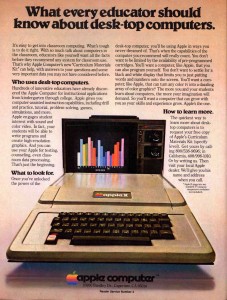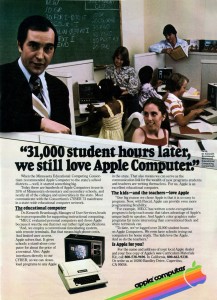In 1978 the Minnesota Educational Computing Consortium (MECC), home of Don Rawitsch and his game The Oregon Trail, was on the cutting edge of computers in education — so much so that, long before business or the general public took much notice of the things, it began considering how to bring microcomputers into Minnesota classrooms as a supplement to the teletypes, dumb terminals, and large time-sharing systems that were the order of the day. MECC went to the leading producers of microcomputers of the time for bids, a list that was of course headed by Radio Shack. The Shack responded in its usual disinterested fashion.
Some of the companies, particularly Radio Shack, were not enamored with this process and thought it was kind of hokey — the process being the bid process and state requirements — and so they weren’t real particular about how they responded. We told Radio Shack, “You know, if you don’t respond in the right way we can’t accept your bid,” and they weren’t willing to change. Everything was flying high and they were selling TRS-80s like mad.
Although most in the MECC bureaucracy would have preferred to deal with large, stable Radio Shack, tiny Apple bid aggressively and enthusiastically, and won the day. MECC ordered 500 Apple IIs, a huge order in a year in which Apple would sell just 7600 machines in total. Granted, Apple discounted the sale so heavily that it’s doubtful they made much of anything from it. But that mattered not a whit. In a storied career filled with savvy marketing moves, Steve Jobs never made a savvier.
MECC not only began moving Apples into Minnesota classrooms, but also began porting its huge library of BASIC educational programs onto the platform. Let’s think about what this state of affairs means for a moment. MECC was already known all over the country as the leader in computer-based education, the example which all of the other more conservative, less well-funded educational institutions tended to belatedly follow. When those folks began thinking about microcomputers for their classrooms, they naturally asked what MECC was using: the Apple II. When they considered educational software, they once again had to take note of MECC’s rich library — a library being rapidly ported to just one microcomputer, the Apple II.
To push the process of educational adoption, by 1979 Apple was beginning to heavily promote the Apple II as an educational tool via advertisements like these:
Jobs realized that getting his computers into schools was the key to conquering a much bigger market: the home. Education was after all one of the most frequently cited reasons that families bought a computer. When Mom and Dad considered what computer to buy for Junior, the Apple II — the computer with all that educational software, the computer that Junior’s school was using, the computer that Junior himself had told them about and already knew how to operate — seemed to many the only logical choice, even if it did cost a bit more and, increasingly as time went on, didn’t have quite as impressive specifications as competing models. Those discounted Apple IIs for schools were loss leaders that paid off handsomely for years. Indeed, as soon as Apple had enough money to make it feasible, they increased their largesse, offering to give an Apple II absolutely free to every elementary school in the country. Moves like that created a stranglehold that even Apple itself was unable to break for years, when it wished the Apple II would just die already in favor of the Apple III and, later, the Macintosh. From the September 24, 1990, edition of InfoWorld:
Nearly 10 years later, elementary schools continue to buy Apple II technology. As a result, the strategy has kept what many industry observers contend is an overpriced and technically obsolete system in the mainstream. And it provided Apple with a virtual lock on the elementary school market that continues today.
That said, there was a bit more than smart marketing behind the Apple II’s classroom domination. Thanks to Woz’s chip- and circuit-saving design as well as the relative primitiveness of the machine itself, there wasn’t much to go wrong on the Apple II internally. And externally the thing was built like a tank. These factors helped the machines survive literally years of abuse at the hands of a whole generation of schoolchildren pounding their keyboards in frustration, poking at their screens with sticky fingers, and jamming the occasional floppy disk into a drive sideways. Teachers grew to love these tough little partners that offered them an occasional reprieve from classes full of wailing children.
Nor is it fair, regardless of the purity or lack thereof of Apple’s motivations in promoting education so heavily, to frame the discussion only in terms of sales and market share. Woz’s hackerish creation found itself a key player in an ongoing debate about the best way to approach education itself. We can perhaps come to understand that by looking at the career of one man, Sherwin Steffin. (Much of what follows is drawn from a portrait of Steffin and his company, Edu-Ware, that appeared in the May, 1981, issue of Softalk magazine.)
Steffin was not one of the young whiz kids of the microcomputer revolution. By the time Apple IIs began arriving in classrooms, he was almost 45 years old, with an impressive career in education already behind him. In addition to earning a bachelor’s degree in experimental psychology and a master’s degree in instructional technology, Steffin had combated gangs as a social worker in Detroit, taught junior high school for seven years, served as media director for a Chicago school district, served as coordinator of instructional system development at Northeastern University for four years, and developed instructional television for the National Technical Institute for the Deaf in Rochester, New York. From 1977, he worked as a senior research analyst at UCLA. The alleged crises in education that he wrestled with there sound eerily familiar today:
Conventional education was in serious difficulty. The end product was being perceived as less competent, less skilled, less curious, and lacking in the desire to learn.
Schools were filled with frustration. The teachers were getting the brunt of the public’s animosity, but the teacher had no mandate within which to work. It seemed that equally as important as teaching reading, writing, and arithmetic were his duties in teaching social skills, making the students patriotic, keeping them off drugs, and teaching them sex education without enlightening them about sex.
“Educational technologists” of Steffin’s generation tended to be greatly enamored with the theories of psychologist B.F. Skinner, inventor of “radical behaviorism.” Skinner believed that all human behavior is predetermined by genetics and by previous experience — the idea of a quasi-mystical “free will” was a useless chimera. He wrote a book, The Technology of Teaching, applying radical behaviorism to the field of education, outlining his idea of “programmed instruction.” Skinner proposed education as essentially a series of rote drills: the student is asked a question, responds, and is immediately informed whether her answer was correct, ad infinitum. Educational technologists developed “programmed learning machines,” automated devices to implement the concept of programmed instruction. Not surprisingly, they weren’t a big success. In a rare show of unity, teachers and students alike loathed them. Not only were they inexpressibly dull to work with, but teachers especially found them downright dehumanizing (a sentiment that, given the thrust of his ideas, Skinner may have embraced wholeheartedly). They correctly argued that many subjects, such as art and literature appreciation and critical thinking, could hardly be pounded home through rote drills.
Steffin began to diverge from his peers, finding the programmed learning machines inadequate. All their other failings aside, they were only good for what he called “convergent thinking, meaning that problems are posed and all students are brought to the same answer.” Divergent thinking, the encouragement of individual critical thinking skills and even opinion, was surely at least as important, for he believed that “thinking is the path to freedom.” With the arrival of relatively cheap microcomputers like the Apple II, Steffin saw a much more flexible tool for learning than the straitjacketed programming learning machines. In spite of having no programming experience or innate aptitude, he developed a program called Compu-Read to teach reading skills, first on UCLA’s big institutional system but later on an Apple II he had bought for research purposes. Like so many other semi-professional / semi-hobbyist programmers in those early years, he initially developed software as a sideline, licensing Compu-Read to the biggest of the early Apple II software publishers, Programma International. In the spring of 1979, however, Steffin was laid off from his post at UCLA. Rather than looking for another, he decided to jump into computer education with both feet, founding Edu-Ware in partnership with a UCLA student, Steve Pederson. Together they began churning out software at a feverish clip, copying the disks themselves and selling them in the Ziploc baggies that were typical of the era.
Edu-Ware’s offerings can be divided into three broad categories. Most were competent but plebeian educational drills that, truth be told, were not all that different from the old programmed learning machines. Their names were about as unexciting as their contents: Compu-Read, Fractions, Decimals, Arithmetic Skills, Compu-Spell, Algebra. (At least no one could say they weren’t descriptive.)
In remarkably short order, however, other Edu-Ware programs began to appear that occupied a hazy space at the intersection of educational tool, game, and simulation. Windfall: The Oil Crisis Game placed the player in charge of a large (albeit fictional) oil company. She could and presumably would try to win, of course, but she would also, inevitably, learn about a complex system that had almost broken down to produce the 1979 oil crisis. Network placed her in charge of a television network, balancing shows, schedules, and ratings, and learning about the pressures of mass media in the process. Terrorist focused on another subject much on people’s minds as the Iranian hostage crisis dragged on, placing her in the role of terrorist or government authority in hostage taking, airplane hijacking, or nuclear blackmail scenarios.
Created at a time when most other software either ignored the real world entirely or dealt with it only in the form of military hardware, these programs are remarkable for the way they determinedly engage with real, pressing social questions. But they are not just dry simulations. Each reflects an agenda, makes an argument about the world, making them perhaps the first examples of what has come to be called “persuasive games.” Their procedural rhetoric reflects the liberal worldview of Edu-Ware themselves. Network might even qualify as the first procedural satire, being inspired by the 1976 black comedy film of the same name.
And the third category? They don’t pretend to be simulations, or anything other than games for that matter, but they’re no less fascinating for all that. More on them next time.












